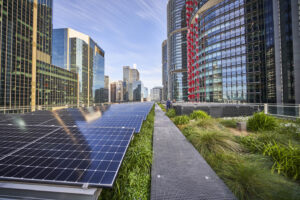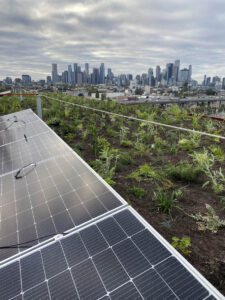
PV panels and green roof combinations are taking charge
By Michael Casey
Our cities are full of built structures with buildings of all shapes and sizes dominating our skylines, and they all have one thing in common – in most cases, they have an underutilised roof space.
Over the course of decades, roof spaces of all shapes and forms have been used to store HVAC (heating, ventilation, and air conditioning) installations, and until recently, photovoltaic panels (PV). Often finished by being painted in a black or dark-coloured water proof membrane, these spaces are heat-absorbing and are an underutilised asset that, to name just a few, could also be used for the installation of green roofs that will assist in addressing challenges caused by urban heat as well as assisting with storm water management, along with increasing biodiversity and improving building thermal capacity.
As progress is made with regards to fully recognising the benefits of urban greenery and its ability to combat climatic conditions, industry participants such as planners, architects, and developers are thankfully adopting progressive ways of addressing roof spaces by mixing plant life and PV panels. The insights and feedback, overall, from university studies and the industry, has been extremely favourable.
Cities such as Melbourne, have approximately 800 ha of roof spaces throughout the city (as identified by City of Melbourne), with a large portion of these spaces possibly being utilised for the installation of greenery. Sydney and Brisbane have similar policies and studies underway, identifying spaces within the cities, and as these three locations share similar cityscapes, along with periods of intense summer heat, there is a compelling case and alignment for the introduction of greenery onto roof spaces. Currently, a lot of roof spaces in our cities are covered in only PV panels and HVAC installations, and in a very limited number of cases, and only up until recently, has there been any inclusion of greenery.. With the recent inclusion in new local projects, combined with studies currently being conducted around the world and locally, this is able shed a new light on the benefits of installing infrastructure alongside nature.
Industry has been referencing and taking note of European and American studies that have been examining these combined benefits for years. An example is a study carried out by German PV manufacturer Polarstern and the Wilhmelm Bucher University, which highlighted the output power of photovoltaic systems. These can be increased by up to 8% if they are installed alongside plants on a green roof.

Locally in Australia, a study was conducted on a recent green roof installation in Barangaroo in central Sydney. This was conducted by the University of Technology Sydney (led by UTS researchers Peter Irga, Fraser Torpy and Robert Fleck), and Sydney-based urban greening company Junglefy. This study provides further evidence aligned to international findings on measuring the benefits of green roofs in cities, with a particular focus on information gathered around the installation of PV panels onto green roofs. Their study noted that surface temperatures on the green roofs were significantly lower, in some cases by up to 20°C, during summer. This reduced roof temperature benefitted the PV panels by allowing them to increase their efficiency of electricity production when surrounded by cooler roof conditions. It also improved working conditions for the panels, equating to a 3.6% increase in solar energy, or valued as an output of $2595 over the eight-month duration of the project (Green Roof & Solar Array – Comparative Research Project Final Report, July 2021).
When considering using plants and PV panels, much like other aspects of greening, there are a number of considerations that need to be addressed. For example, the type of vegetation used and the depth of growing media on green roofs is fundamental when combining with PV panels. The majority of operational benefits of the PV panels when combined with plants comes from the vegetation layer, and its ability to absorb and retain water, and therefore cool (down) the roof space.
Roof gardens with higher substrate levels will allow for deeper rooting of plants and more options with plant selections, with this all working towards the survivability of the plant with the objective of a more dense covering of plant material. Exposing too much growing media will cause the soil to dry out and in some cases warm the surrounding area. The growing habits of plant species will also need to be planned carefully, especially in relation to the overall height of the plants. Plants growing too high will reduce energy production through shading the PV panels, and may also damage the panels if left unmaintained. This is particularly an issue when woody plants become established.
Another challenge that can be overlooked is when panels are laid/fixed on an angle (which are often seen on roofs). They can create a water capture zone that then drips onto the garden below resulting in an increase in plant growth close to these panels. Areas around these drip zones may need to have their maintenance increased during times of heavier rainfall to ensure plant height and density is addressed. A couple of useful considerations in these areas is to decrease the depth of growing media to limit root growth, and also to use deflecting trays if the drip line starts to cause too many issues with excessive water diverted to these areas of garden.
Another important consideration is to address the potential for fire risk. As building regulations can vary from state to state, and in different countries, it should be of high focus to ensure when designing these spaces that local fire regulations are adopted/adhered to. Recent studies from Europe and America have noted that the risks are minor during most days of a ‘normal year’ in European and North American climates, however, if fires were recorded they were mainly started from malfunctions in the electrical system’s connectors, switches and other contact points. Of interest in these studies was that the high insulation values of the growing media on green roofs effectively protected the roof build-up from fire hazard**, however they noted that the buildup of dry plant material in the garden and around the panels should always be removed to reduce further risks.
The increase in local and international projects highlighting the use of PV panels and greenery within crowded city roofs is very positive, and the path forward is being defined by companies at the forefront of these innovative installations. Industry designers, planners, and policy makers need to mandate these installations to achieve more positive outcomes for our cities. At present, these installations are ‘nice to have’, and not a pre-requisite, as progressive/forward thinking developers are capitalising on the rewilding of our cities while using the best technology to create renewable electrical energy. Not only do these PV and planting combinations provide a saving to the building occupants, but also to the relevant stakeholders, and last but not least, the general public and occupants of cities.
References:
** N. Gerzhova, P. Blanchet, C. Dagenais and S. Ménard, Flammability Characteristics of Green Roofs, Buildnings, July 2020.
R. Miller and N. Gerzhova, Understanding the Behaviour of Fire and Green Roofs, Living Architecture Monitor, 2021.
Department for Communities and Local Government, Fire Performance of Green Roofs and Walls, Department for Communities and Local Government, London, 2013.
Michael Casey
Director of Evergreen Infrastructure and MJC Horticulture
Advisor to the green infrastructure industry.
E: michael@evergreeninfrastructure.com.au
Main photo: Solar panels integrated with green roof on Daramu House, Gadigal Land (Image: Lendlease)
